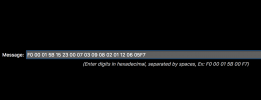mattytraxx
New Member
Will MIDI SysEx messages be available to control loop order?
| CC88 | 0 127 | Loop 1 (stereo/mono) OFF Loop 1 (stereo/mono) ON |
| CC89 | 2 | |
| CC90 | 3 | |
| CC91 | 4 | |
| CC92 | 5 | |
| CC93 | 6 | |
| CC94 | 0 127 | Loop 7 (split mono) OFF Loop 7 (split mono) ON |
| CC95 | 8 | |
| CC96 | 9 | |
| CC97 | 10 | |
| CC98 | 11 | |
| CC99 | 12 |
| CC (Refers to a position) | Value (Loop to assign) | Position in audio chain |
|---|---|---|
| CC101 | 1 2 3 4 5 6 7 8 9 10 11 12 | First position = Loop 1 First position = Loop 2 First position = Loop 3 First position = Loop 4 First position = Loop 5 First position = Loop 6 First position = Loop 7 First position = Loop 8 First position = Loop 9 First position = Loop 10 First position = Loop 11 First position = Loop12 |
| CC102 | 1..12 | CC102 controls which loop is SECOND |
| CC103 | 1..12 | CC103 controls which loop is THIRD |
| CC104 | 4th | |
| CC105 | 5th | |
| CC106 | 6th | |
| CC107 | 7th | |
| CC108 | 8th | |
| CC109 | 9th | |
| CC110 | 10th | |
| CC111 | 11th | |
| CC112 | 12th |
| CC100 | 0 127 | BEGIN loop reordering END loop reordering |
I was trying to add a sysex that completely re-orders the pedals as a test, but unfortunately after about 7 or 8 loops the MMGT editor wouldn't allow me to enter a space between the loop numbers (ie, after loop 05 I couldn't place a space and finish entering the rest of the loops).Ok, I did some late night programming and added a Sysex command. I decided against using CCs due to their limitations. The first CC method makes it hard to specify a complete loop order, since you are always moving 2 loops per command. The second one requires the start/stop commands to get into the loop reordering mode, which makes it error prone. The method I implemented requires a controller that can send sysex, but if you have that, you can specify the whole loop order in one go.
The command is
F0 00 01 5B <sysex id> 23 00 <position 1> <position 2> ... F7
Sysex ID is configurable on each MEG unit using the editor, default is 21 or 15 in hex.
After the command ("23 00"), you specify the loop numbers in the order you need them. Loop numbers are specified as 1 through 12 (01 through 0C hex). Any loop numbers not specified are added to the end of the loop order, in numerical order.
Examples:
F0 00 01 5B 15 23 00 06 05 04 03 02 01 F7
Loop order: 6, 5, 4, 3, 2, 1, 7, 8, 9, 10, 11, 12
F0 00 01 5B 15 23 00 03 05 F7
Loop order: 3, 5, 1, 2, 4, 6, 7, 8, 9, 10, 11, 12
F0 00 01 5B 15 23 00 F7
Loop order: 1, 2, 3, 4, 5, 6, 7, 8, 9, 10, 11, 12
(FYI, the system requires all of the possible 12 loops be accounted for in the loop order specification, even if you aren't using them all. That's why the MEGX fills in the missing loops. If the loops don't exist in your configuration, or are turned off, they are ignored. But they still need to be in the loop order in case you ever do change your configuration. If a loop isn't in the loop order, you would never be able to turn it on).
I may add other methods to specify loop order later, but at least this gives you something to work with.

